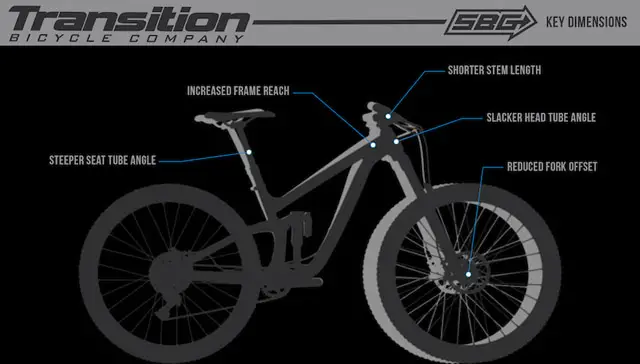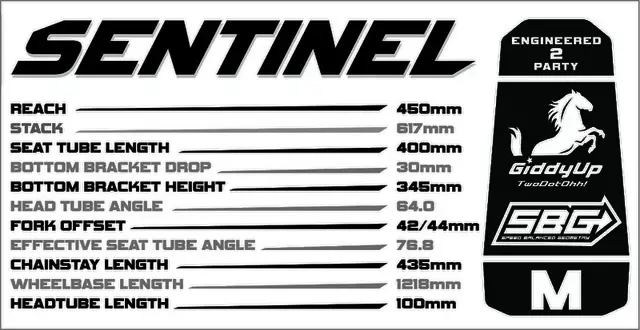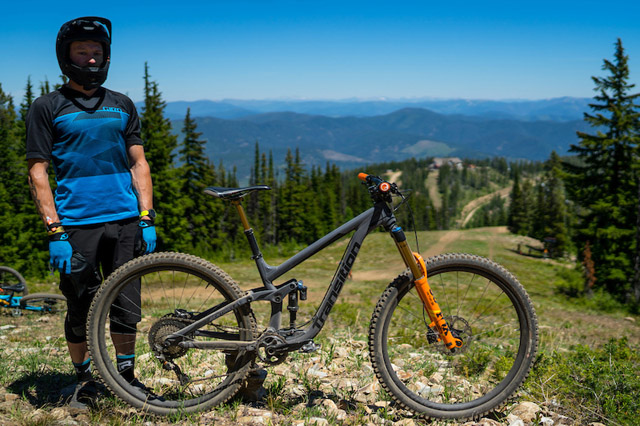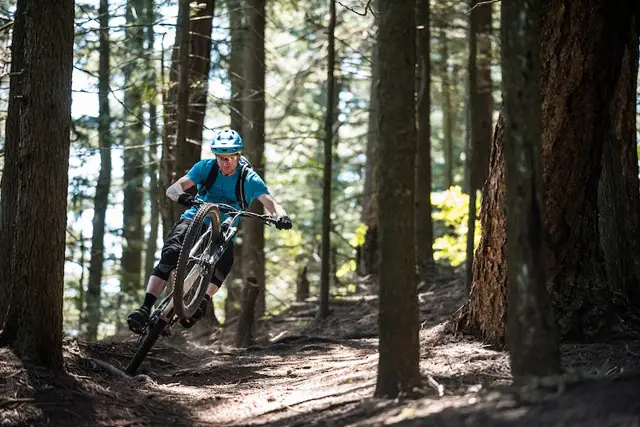Earlier in the week, Hannah spotted a brand new model of mountain bike from the Washington-based crew from Transition Bikes. As it turns out, Hannah’s detective work proved correct, with Transition announcing it will indeed be offering a new long-travel 29er called the Sentinel, due to arrive this Autumn.
As of right now it’s a soft-launch from Transition on the Sentinel, so we’ll have to wait for more details. But the big news right now from the beer-swilling ya-hoo’s at Transition isn’t just about a new bike, but a whole new geometry concept that will be rolled out through the entire lineup. Dubbed ‘Speed Balanced Geometry’, Transition is announcing it’s full commitment to the slacker/longer/lower church, along with a couple of key twists that it believes will make its new generation full suspension bikes a whole lot faster, and a whole lot radder to ride.
Check out the full word and video from Transition Bikes below;
Here’s the thinking behind the new ‘Speed Balanced Geometry’ from Transition Bikes;
“Inspired by this dream, late in 2015 we initiated a research program led by our Blue Balls Development Team to discover ways we could make our current bikes handle even better. We began an extensive test cycle with different variations of fork offset and geometries. Why you ask?
In the last 5 years, your mountain bike has changed in in many ways. Your wheels have likely gotten bigger. Your frame has gotten longer. Your head tube has gotten slacker. Your suspension has improved. Your stem has gotten shorter and your bars have gotten wider. And you likely have a remote dropper seat post opposed to a straight post. Your components have improved in ways that have allowed you to ride easier, farther and harder. Yet, the there are some things that haven’t been updated with the rest of these improvements. One of these things is steering trail.
Trail is one of the dimensions that relates to particular steering feel and handling characteristics. Current trail figures fall between a regular set of parameters depending on wheel size and bike suspension travel. The thing is, this range of trail is based on an old legacy of 26″ bikes with outdated geometry; steep head tube angles, shorter reach and top tube, longer stems and skinnier handlebars.
Why shouldn’t this evolve with the rest of your bike?”
https://vimeo.com/223517144
Now lets make this clear straight up. Transition isn’t the first brand to kick frame geometry out of the box. There have been many innovators over the last 40 years of mountain biking technology, though without doubt it was Mondraker who pushed the radical ‘Forward Geometry’ concept back in 2012, with enormous front-centre lengths paired to tiny 10mm long stems, which has had one of the biggest influences in recent times. Then we’ve had the likes of Chris Porter from Mojo Suspension take the idea to the next level with the uber-slack Nicolai Geometron series, while Finnish-based Pole went even further by pairing the uber-slack head angles and long front centre idea along with enormous chainstays to create seriously long wheelbases on the 140mm travel Evolink.
More recently, we’ve seen Cesar Rojo (the original brains behind the Mondraker Forward Geometry concept), launch his own bike brand called Unno, which will be centred around a similar idea of the long-reach-slack-head-angle thing.
Beyond those examples, there are many more signs of geometry progression throughout the wider bike industry, with even the big players taking note of the recent evolution. However, Transition claims that it’s Speed Balanced Geometry is designed to not just increase one or two of those variable numbers, but to address all of them in the same single design.

For a start, Transition’s new SBG system will push the reach number out further than its current range of bikes. The frames will also be designed specifically around a shorter 40mm stem length, rather than the current 50mm length, keeping the overall reach to the bars about the same. In addition, steeper seat tube angles will centre the rider weight to help improve the climbing position.
Head angles will (of course) get slacker, with two goals in mind. One being more descending stability, and the other being improved suspension performance by aligning the fork stroke more inline with the impacts coming from the trail ahead. This reduces fork deflection, and in theory, allows for smoother fork operation. Oh, and they also claim there’s less brake dive with a slacker angle too.
The last piece, and arguably the most interesting piece of the puzzle is fork offset. In prior years, most brands have elected to use a longer fork offset when running larger 29in (or 27.5in) wheels, in order to reduce the trail figure. The theory is that a smaller trail figure allows for faster steering, counter-acting the effects of a slack head angle. According to Transition however, a shorter fork offset brings the wheel slightly closer to the rider for added traction, whilst providing quicker steering via the shorter 40mm stem.
Or at least, that’s what it says on the tin…

Transition is pretty excited about what it has going with the SBG concept, and it’s clear that it’ll not only adopt this concept for the new Sentinel 29er, but the wider full suspension range. We’ll have to wait for further information about the new Sentinel, but for now we have the above geometry chart for a Medium sized frame to give us an idea of what to expect. One further clue in the geometry table is the fork offset, which is listed as 42/44mm. That could mean one of two things; either the Sentinel will be available with both RockShox and Fox fork options, and each brand may only be offering one specific fork offset for the time being. Or, the Sentinel may be coming in both 29in and 27.5in versions, with the 29er likely getting the longer 44mm offset.
Yet again, time will tell…
In the meantime, we’ve got loads of questions about frame geometry and the concept of running a shorter fork offset with a slacker head angle, given that many brands have been going the opposite way (Gary Fisher’s G2 geometry and Cannondale’s Lefty forks being the two immediate examples that come to mind). We’ll be getting in touch with a few key industry players to get their opinions on modern frame geometry, fork offset, trail and how it all comes together on the trail. Stay tuned for a geek-fest soon!







We’re getting a repeat of the 1920s. Low and slack.
They should really call it Descending Bike Geometry though.
But where’s the Flapper girls? 🙂
slacker head angle = more trail,
less fork off set = more trail,
so this bike has lots of trail? so how is it nimble, as they say in the video?
not that i don’t believe them. my bike feels like it has too much trail when just riding on the road – floppy steering. but i love how it handle off road, and front does have good traction
So they only thing they’re actually doing that’s of any difference to pretty much every other bike company is alter the fork offset? Coming up with some **** name to conceal this really doesn’t help their case. Steeper seat angle, slacker head angle, shorter stem, increased reach etc are common place changes with every new bike…
Isn’t this just going back to roughly the original fork offset for 29ers? And it’s worth noting Trek/GF G2 geometry has been around for ~10 years. Gary.Fisher was the one who pushed this evolution more than anyone.
Blue Balls Development Team
Ahem…
Orbea also had this at their recent Rallon bike launch.
jamiesilo – I think the theory is that it’s not trail doing that floppy steering, it’s how far in front the wheel is. With this you get the advantage of a slack head angle, but don’t keep casting the front wheel further and further ahead.
See this from a couple of years ago, http://www.bikeradar.com/mtb/gear/article/pushing-the-limits-of-fork-offset-an-experiment-45343/ and of course the Geometron